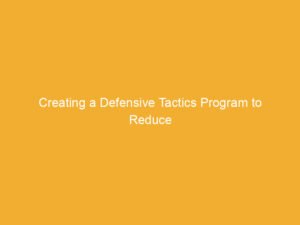
How Much Does Workers’ Comp Cost a GA Staffing Agency?
September 18, 2025
Georgia Security Guard Workers’ Comp Quote Checklist—Get Faster Approvals
September 18, 2025In the security industry, the safety and well-being of personnel are paramount. Security guards frequently face unpredictable and potentially hazardous situations that can lead to physical injury, impacting not only their health but also operational efficiency and organizational reputation. Developing a comprehensive defensive tactics program is essential for mitigating these risks by equipping guards with the skills and strategies necessary to protect themselves effectively while maintaining control and professionalism. This article explores the key components and best practices for creating a defensive tactics program aimed at considerably reducing security guard injuries, thereby enhancing workforce safety and overall security performance.
Table of Contents
- Assessing Risk Factors and Injury Patterns Among Security Personnel
- Developing Comprehensive Training Modules focused on Defensive Techniques
- Integrating Scenario-Based drills to Enhance Real-World Responsiveness
- Implementing Continuous Evaluation and Feedback Mechanisms for Program Improvement
- Q&A
- In Summary
Assessing Risk Factors and Injury Patterns Among Security Personnel
Understanding the multifaceted nature of risks faced by security personnel is crucial for crafting an effective defensive tactics program. Common risk factors include the unpredictable behavior of unauthorized individuals, environmental hazards such as poorly lit areas, and the physical demands of long shifts. Additionally, stress and fatigue can exacerbate vulnerability, leading to increased chances of injury. By systematically analyzing these elements, organizations can prioritize interventions that align with the most prevalent injury trends.
Data gathered from incident reports consistently highlights a pattern of injuries predominantly involving:
- Musculoskeletal strains due to physical altercations or excessive physical exertion
- Contusions and abrasions from falls or confrontations
- Exposure-related injuries such as heat stress or cold-related conditions
To visualize these injury occurrences, consider the following frequency breakdown:
| Injury Type | Percentage of Total Injuries |
|---|---|
| Musculoskeletal Strains | 45% |
| Contusions and Abrasions | 30% |
| Exposure-Related Injuries | 15% |
| Other | 10% |
Developing Comprehensive Training Modules Focused on Defensive Techniques
To equip security personnel with the skills necessary to prevent injuries, training modules should encompass a diverse range of defensive techniques tailored to real-world scenarios.Core components include situational awareness, controlled physical responses, and the psychological aspects of conflict de-escalation.Modules must be designed with progressive difficulty, beginning with foundational movements and advancing to complex defense maneuvers. Including video demonstrations, hands-on practice sessions, and scenario-based drills enhances skill retention and builds confidence under pressure.
- Verification of Individual Skill Mastery: Regular assessments ensure proficiency at each training level.
- Customized Approach: Adapt modules to reflect specific risks faced by security staff in various environments.
Incorporating a balanced curriculum that highlights legal considerations alongside physical defense ensures guards maintain professionalism while protecting themselves and others. A well-structured training plan includes modules on:
| Module | Focus Area | Outcome |
|---|---|---|
| Physical Techniques | Controlled Holds, blocks, Evading Attacks | Reduced injury through effective body mechanics |
| Verbal De-escalation | Communication, Conflict Resolution | Lower on-site aggression levels |
| Legal & ethical Boundaries | Use of Force Laws, Liability | Safeguarding guard and company accountability |
This comprehensive approach ensures guards are not only physically prepared but also strategically equipped to minimize injury risk and enhance overall operational safety.
Integrating Scenario-Based Drills to Enhance Real-World Responsiveness
To effectively bridge the gap between theory and practice, scenario-based drills serve as an indispensable tool in defensive tactics programs. These simulations place security guards in realistic, high-pressure situations where decision-making and rapid reflexes are crucial. By repeatedly engaging in controlled, yet dynamic, scenarios such as altercations, emergency evacuations, or threat identifications, guards develop muscle memory and mental acuity that directly translate to real-world readiness.This experiential learning approach not only reinforces procedural knowledge but also builds confidence and reduces response time during actual incidents.
Implementing such drills requires a structured approach to maximize their impact, including diverse scenarios and measurable performance metrics. Below is a sample framework illustrating how drills can be organized to ensure comprehensive skill development:
| drill Type | Focus Area | Key Outcome |
|---|---|---|
| Physical Confrontation | Control techniques, restraint | Safe and effective subduing |
| Emergency Evacuation | Situational awareness, crowd control | Efficient evacuation with minimal injury |
| De-escalation | Communication, conflict resolution | Reducing escalation and force |
| Weapon Identification | Threat detection, rapid response | Improved threat neutralization |
Consistently updating scenarios to reflect evolving security challenges ensures guards remain adaptive and capable. Incorporating feedback and performance reviews after each drill reinforces lessons learned and identifies areas for improvement, leading to a safer working surroundings and a marked decrease in injury rates.
Implementing Continuous Evaluation and Feedback Mechanisms for Program Improvement
Establishing a robust system for ongoing assessment is vital to ensure the defensive tactics program evolves alongside emerging risks and operational challenges. Stakeholders must implement structured feedback channels that encourage active participation from security personnel at all levels. This can be achieved through regular surveys, anonymous suggestion boxes, and post-training debriefs, fostering a culture where frontline insights directly influence adjustments to tactics and training materials. Such mechanisms provide invaluable real-time data, enabling program administrators to pinpoint training gaps and operational inefficiencies before they translate into injuries or lapses in security.
Integrating comprehensive data analytics tools further enhances decision-making accuracy by transforming qualitative feedback into measurable outcomes. the following table illustrates key performance indicators (KPIs) essential for continuous program refinement, with recommended review frequencies designed to maintain agility and relevance:
| KPI | Description | Review Frequency |
|---|---|---|
| Incident Rate | Number of injuries sustained during security operations | Monthly |
| Training Compliance | Percentage of guards completing required training sessions | Quarterly |
| Feedback Engagement | Participation rate in surveys and debrief sessions | Bi-Monthly |
| Tactical Adjustment Success | Effectiveness of implemented changes based on feedback | After each adjustment |
- Encourage openness: Share insights gained from evaluations to build trust.
- Act promptly: Address critical feedback without delay to prevent escalation.
- Leverage technology: Utilize digital platforms for seamless communication and data tracking.
- Promote continuous learning: Integrate lessons learned into refresher courses and simulations.
Q&A
Q&A: Creating a Defensive Tactics Program to Reduce Security Guard Injuries
Q1: Why is it important for security companies to implement a defensive tactics program?
A1: Implementing a defensive tactics program is crucial because it equips security guards with practical skills to protect themselves while minimizing injury risks. This not only improves guard safety but also enhances operational effectiveness, reduces liability, and lowers costs related to worker compensation and legal claims.
Q2: What are the key components of an effective defensive tactics program?
A2: An effective program includes comprehensive training on situational awareness, communication skills, de-escalation techniques, physical self-defense methods, use of force policies, legal considerations, and regular scenario-based drills. ongoing refresher courses and performance assessments are also essential for maintaining skill proficiency.
Q3: How can defensive tactics training specifically reduce security guard injuries?
A3: Defensive tactics training teaches guards how to avoid or control confrontations safely and legally. Techniques focus on minimizing physical harm through controlled movements and appropriate force request, leading to fewer injuries from falls, strikes, or improper restraint. Additionally, improved awareness helps guards anticipate threats and act proactively to prevent violence.
Q4: What role does de-escalation play in reducing injuries within a defensive tactics program?
A4: De-escalation is a foundational element that aims to resolve conflicts verbally before physical intervention becomes necessary. Training security personnel in communication and negotiation skills reduces the frequency and intensity of physical altercations, directly lowering the likelihood of injury.
Q5: how should a company measure the effectiveness of its defensive tactics program?
A5: Effectiveness can be measured through metrics such as reduced injury rates, decreased use-of-force incidents, lower worker compensation claims, and positive feedback from guards regarding confidence and preparedness. Regular incident reviews and training evaluations provide actionable insights for continuous improvement.
Q6: What challenges might an association face when implementing a defensive tactics program, and how can they be overcome?
A6: Common challenges include budget constraints, resistance to new training protocols, and varying skill levels among guards.These can be addressed by demonstrating the program’s ROI through injury reduction data, involving guards in program development, tailoring training to different proficiency levels, and scheduling sessions to minimize operational disruptions.
Q7: How frequently enough should security guards undergo defensive tactics training?
A7: Initial comprehensive training should be conducted upon hiring, followed by mandatory refresher courses at least annually. Frequency may increase based on regulatory requirements, incident history, or job role changes to ensure ongoing competency and adherence to updated best practices.
Q8: Can technology complement a defensive tactics program?
A8: Yes, technology such as virtual reality simulations, online learning modules, and body-worn cameras can enhance training delivery, provide realistic scenario practice, and facilitate incident review. These tools help reinforce skills and promote accountability.
This Q&A provides a structured overview of establishing a defensive tactics program aimed at reducing security guard injuries, highlighting strategic benefits and practical considerations for businesses.
In Summary
developing a comprehensive defensive tactics program is essential for enhancing the safety and effectiveness of security personnel. by investing in targeted training that emphasizes injury prevention, situational awareness, and controlled response techniques, organizations can significantly reduce the incidence of on-the-job injuries among security guards. This not only promotes a safer working environment but also improves operational efficiency and reduces associated costs related to worker compensation and downtime. Ultimately, a well-structured defensive tactics program serves as a strategic asset, empowering security teams to perform their duties with confidence and resilience.
“This content was generated with the assistance of artificial intelligence. While we strive for accuracy, AI-generated content may not always reflect the most current information or professional advice. Users are encouraged to independently verify critical information and, where appropriate, consult with qualified professionals, lawyers, state statutes and regulations & NCCI rules & manuals before making decisions based on this content.

